
Logan and Albert Conservation Association

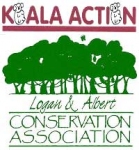 The article by Brian Williams in the Courier Mail for 29 May 2009 is sobering reading. It also provides an opportunity for any concerned resident to comment with information of their own experiences.
The article by Brian Williams in the Courier Mail for 29 May 2009 is sobering reading. It also provides an opportunity for any concerned resident to comment with information of their own experiences.
Click on the following text to make your observations or comment. Have your say: Have you noticed a decline in koala numbers?
Call to list koalas as vulnerable relates the plight of the iconic koala whose habitat has been eroded by clearing for development.
Read the article, submit your comment and please consider sending a letter to Sustainability Minister Kate Jones, Federal Environment Minister Peter Garrett and Queensland Premier Anna Bligh.
CONSERVATIONISTS have applied for southeast Queensland koalas to be listed as vulnerable.
If listed under federal laws, the Environment Protection and Biodiversity Conservation Act will kick in, forcing anyone clearing land in koala habitat to ensure it does not affect the animal's prospects for survival. The report just released by Sustainability Minister Kate Jones last week confirmed that koala numbers had declined by 64 per cent in the past decade.
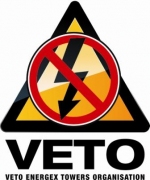 CURRENT EPETITION
CURRENT EPETITION
Queensland residents draws to the attention of the House the community's total opposition to the construction of this power line because it will be a permanent obtrusive and dangerous structure that will cause:
- damage to this unique environment by destroying vegetation, native animal habitat and resulting in erosion of the riverbank, the loss of community amenity and visual amenity (restricting current and future uses of the river by visitors and residents and spoiling this beautiful green landscape and valuable community asset);
- potential health and safety risks to residents, maintenance and emergency workers during floods and to grazing and native animals; and
- adverse impacts on property values.
The House should note that the construction of this power line totally contradicts the principles of the Queensland Government's Towards Q2 plan (Green Qld - Protecting our Lifestyle and Environment) which stresses the need to 'protect our natural landscapes' and to 'retain the green spaces between neighbourhoods and regions that create a natural break in our built environment and protect areas that support our unique native wildlife and fragile ecosystems'.
 International environmental news sources report that Australia's Tasmanian Devil, its population decimated by a facial cancer, was listed as an endangered species on Wednesday by the Tasmanian state government 21 May 2009. msncb.msn.com shows a picture taken on January 13, 2009 of a healthy Tasmanian devil joey (Sarcophilus harrisii) displayed as part of an intensive conservation programme, because of the spread of an infectious facial tumour which gradually disfigures the animal's face to the point it is unable to eat, at Taronga Zoo in Sydney.
International environmental news sources report that Australia's Tasmanian Devil, its population decimated by a facial cancer, was listed as an endangered species on Wednesday by the Tasmanian state government 21 May 2009. msncb.msn.com shows a picture taken on January 13, 2009 of a healthy Tasmanian devil joey (Sarcophilus harrisii) displayed as part of an intensive conservation programme, because of the spread of an infectious facial tumour which gradually disfigures the animal's face to the point it is unable to eat, at Taronga Zoo in Sydney.
Australia's Tasmanian devil is the world's largest surviving marsupial carnivore. This increased risk of extinction status change means that more resources and measures will / can be allocated for greater protection and recovery strategies. Numbers have declined by 70 percent since cancer was first reported in '96.
The deadly and disfiguring facial cancer, which often kills within months, has cut the island state's wild devil population by as much as 60 percent. The Tasmanian Devil faces extinction in 10 to 20 years due to the facial cancer.
"We are committed to finding an answer and saving the Tasmanian Devil for Tasmanians and the world," Tasmanian Primary Industries Minister David Llewellyn said in a statement announcing the change in status from vulnerable to endangered.
The Tasmanian Devil is a carnivorous marsupial about the size of a small muscular dog. It has black fur, gives off a skunk-like odour when stressed, and earns its devil name for its ferocious temperament and disturbing call. The facial cancer is genetically identical in every animal and originated from a single contagious cell line and spread throughout the population by biting during fights for food and mates.
"We are developing and implementing an insurance strategy which has established captive populations around the country, implementing wild management trials to attempt to secure wild populations," said Llewellyn.
Llewellyn said he was encouraged by the fact that some devils from western Tasmania had developed antibodies to facial tumor.
"While it is still very early days, discoveries such as this provide hope that the disease may be managed in the longer term and that devils with genetic diversity will survive it," he said.
The story with more links can be read here at msnbc.msn.com
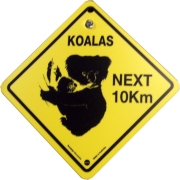 The latest report from the EPA and Courier Mail today on the 50% decline in Koala Coast koalas in the last 3 years is sobering news. The koala coast region includes the Redlands Council, east side of Logan Council and Brisbane City council. The koala population in the Koala Coast has been identified as genetically different to koalas in other parts of SE Qld which makes them even more important to protect for biodiversity values.
The latest report from the EPA and Courier Mail today on the 50% decline in Koala Coast koalas in the last 3 years is sobering news. The koala coast region includes the Redlands Council, east side of Logan Council and Brisbane City council. The koala population in the Koala Coast has been identified as genetically different to koalas in other parts of SE Qld which makes them even more important to protect for biodiversity values.
The Koala Coast area has had regions "protected" for the longest period of time as koala conservation areas and koala sustainability areas as part of the koala mapping that state government (EPA) has conducted in the past. The koalas of the "new Logan" Council area and Scenic Rim have not yet been mapped . Our koalas would certainly be in a worse position.
It is also important to note that the koala mapping conducted in Moreton Regional Council also confirmed that their Koala population had also declined. This news as reported on line in the Courier Mail is available here.
The Environment and Protection Agency EPA - Queensland government department - has published the findings and report from GHD on its www.epa.qld.gov.au page here.
The latest EPA report concerning the decline of the Koala Coast koalas has be provided for us.
You can access the document here. Decline_of_the_Koala_Coast_Koala_Population_Population_Status_in_2008.pdf 301.46 Kb 24/05/2009, 14:32
Decline_of_the_Koala_Coast_Koala_Population_Population_Status_in_2008.pdf 301.46 Kb 24/05/2009, 14:32
[Article in progress]
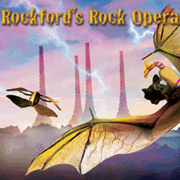 Rockford's Rock Opera is an original ecological musical story for children and adults which addresses the most serious environmental issues in a uniquely entertaining and yet thoughtful manner. And it's proving a huge hit around the world. Scripted by BBC comedian Steve Punt, and with music by Sweetapple, it tells the story of the Island of Infinity - home to all the world's extinct creatures.
Rockford's Rock Opera is an original ecological musical story for children and adults which addresses the most serious environmental issues in a uniquely entertaining and yet thoughtful manner. And it's proving a huge hit around the world. Scripted by BBC comedian Steve Punt, and with music by Sweetapple, it tells the story of the Island of Infinity - home to all the world's extinct creatures.
Rockford's Rock Opera is an amazing adventure in sound for adults and children. Part One of the story (six chapters: 52 minutes) is free! It features narration, read along text, characters, sound effects and music and is available as a free mp3 download and an audio stream.
Great to listen to on your computer, your ipod or burnt onto CD, this is a free audiobook like no other. The website also contains useful background information about the story (including key information and free downloadable teaching resources about extinction and ecology), how the story was made and the facts behind the fiction.
Visit the website by clicking on link to the left to access free book and lots of other resources, perhaps even buy some products. WWF is supported by this group.
Are you concerned about an ecologically sustainable future for Logan and all who live within the boundaries of almost 1000 square kilometres of the combined low density rural residential north Beaudesert area and the more urban settlements of Logan?
We all, the residents and citizens of Logan, have an opportunity to work together to learn to protect and enhance the natural environment. This does and will provide habitat and homes for the many native animals and also sustain the sub-tropical atmaosphere which we humans enjoy so much. Many creatures are being displaced and killed as a result of inappropriate clearing of vegetation.
A rapidly increasing human population is the driving force behind the eight proposed major development areas in Logan City. There has been no analysis of the carrying capacity of South East Queensland to place perhaps some constraints and conditions on developments.
The land has been, and is still, treated as a commodity from which we make money. The real cost has seldom been paid. With genuine ecologically sustainable development a balance can be achieved.
To take part in this forum you must belong to an incorporated group and be nominated as their representative. All members of such groups can raise concerns at group meetings and these may be included in the forum discussions.
Logan City Deputy Mayor, Councillor Russell Lutton, in supporting the new structure and leadership team, commended the decision to establish the new City Leadership Cabinet and said that the new Cabinet has been appointed to oversee the direction of the city and to ensure improved process and quality of decision-making in Standing Committees.
The new structure and leadership team were formally ratified at a Special Meeting of Council May 19, 2009.
 Cardno Eppell Olsen are the consultants for the Mt Lindesay/Beaudesert Strategic Transport Network Investigation which aims to determine the long term (50 years) transport needs in the Mt Lindesay - Beaudesert area. The study investigates potential future land use scenarios and assesses transport system options for the future. The study recommendations will be used to guide future planning for the area.
Cardno Eppell Olsen are the consultants for the Mt Lindesay/Beaudesert Strategic Transport Network Investigation which aims to determine the long term (50 years) transport needs in the Mt Lindesay - Beaudesert area. The study investigates potential future land use scenarios and assesses transport system options for the future. The study recommendations will be used to guide future planning for the area.
This study by the Department of Transport and Main Roads is looking at the longer term transport needs of the Mt Lindesay/Beaudesert region over the next 50 years and will identify the strategic level transport options required to support the expected growth in the area. The findings will help state and local governments plan now for the delivery of future transport networks.
The draft report can also be viewed at the following locations until 12 June:
• Beaudesert QGAP;
• Logan City Council Customer Service Centre;
• Scenic Rim Council Office (Beaudesert)
• Greenbank, Jimboomba, Logan Village and Logan West Libraries.
Public comment and submissions on the draft report are invited until 12 June 2009 and will be considered in the final report.
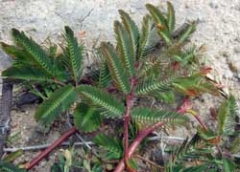 The hunt is on for a pest weed being grown as a vegetable commonly used in Asian dishes.
The hunt is on for a pest weed being grown as a vegetable commonly used in Asian dishes.
Water Mimosa is the worst kind of weed in Queensland - a Class 1 declared weed that is highly invasive and endangers waterways. Minister for Primary Industries, Fisheries and Rural and Regional Queensland Tim Mulherin is asking south-east Queensland communities to help find it. "Water mimosa is an aquatic weed that can release nitrogen into waterways, which affects water quality and can lead to increased algae," Mr Mulherin said.
"The nitrogen levels also create the perfect growing environment for other declared water weeds, which kill our native wetland plants and fish."
Class 1 declared weeds are subject to eradication from the state and Biosecurity Queensland and local government officers will be out to track down this dangerous weed. Biosecurity Queensland is undertaking an awareness campaign to educate the public about why water mimosa is a declared weed and what their responsibilities are in relation to eradicating the weed.
How did our grandparents survive without all the modern conveniences 'mod cons' that we have access to today? This website www.theshoppe.com.au has an invaluable wealth of information on common kitchen ingredients that can be used for cleaning - these are what I use. This information is taken from a free downloadable newsletter.